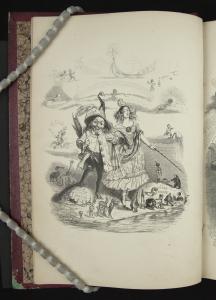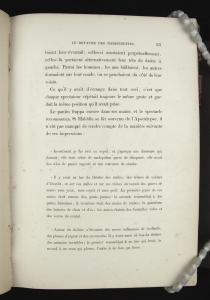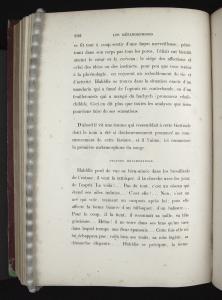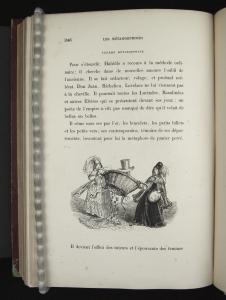

Un autre monde : transformations, visions, incarnations, ascensions, locomotions, explorations, peregrinations, excursions, stations, cosmogonies, fantasmagories...
1. The complaint, and the consolation; or, Night thoughts
2. The Fables of Æesop, and others / With designs on wood, by Thomas Bewick
5. News from nowhere: or, An epoch of rest, being some chapters from Utopian romance
6. The nature of Gothic, a chapter of the stones of Venice
7. Daphnis and Chloe: a most sweet abd pleasant pastoral romance for young ladies
8. The Sphinx
10. Credo
14. Bible.Old Testament. Song of Solomon.
16. Kem byt’? / V. Mai︠a︡kovskiĭ ; ris. N. Shifrin.
17. The ghost in the underblows
19. Bateau ivre
UCLA Call Number: CBC * NC1499 .G76a 1844

Un autre monde : transformations, visions, incarnations..
In this caricature, Grandville attempts to usurp the status of writers. The person who is in charge, indicated by wearing a hat on which is written “La Charge,” is in fact an artist based on the illustration, in which he dons a painter’s smock. It clearly reflects the artist’s (illustrator’s) self‐proclaimed sovereignty over writers. The artist and writer are moving from the old world where the writer assumed intellectual and artistic superiority to another world where the artist assumes the old role of the writer. The various images behind the main figures serve as harbingers and forecast the story to come. It is interesting that he designates the artist “La Charge” as a woman.

Un autre monde : transformations, visions, incarnations..
Hahblee travels by air and lands in a kingdom. In this image, objects slowly dissolve into nonidentical objects in transformational pictures. For example, a pair of legs becomes a ballerina, then turns into a spinning top, then into a donkey. Audience seats are occupied with clapping hands, bottles, and wine glasses, watching coins flying out of a sack and hearts dissolving into rings. The ephemerality of the images conveys modernity. In this caricature, Grandville attempts to mock the prevailing materialism in the society. In a theatre setting, the audience is more interested in the sexuality of a ballerina than of her performance.

Un autre monde : transformations, visions, incarnations...
This image depicts Grandville’s signature transformational forms morphing from a bird, to a bow, to a flower in a vase, to a beautiful woman in a dress holding a flower, and then the woman disappears and becomes a serpent.

Un autre monde : transformations, visions, incarnations...
Creator: Grandville, J.J.
Publisher: Fournier, H
Publication Place:Paris
Date of Publication: 1844
Dimensions: 28 cm x 19 cm
Technologies of Production: wood engraving
Physical Description:
This book is ex-libris of Charles Boyer who purchased it for $12.50.
Condition: Quarter bound in red morocco leather, stamped in gilt with four raised spine bands; red cloth over boards. Black and brown marbled endpapers. Edges are worn and show the original green publisher’s cloth
Additional Info:
Note of authenticity with statement: the names of neo-gods (Puff, Krackq, and Hahblle) serve as authenticity. On the title page, the seal of these characters is printed.
Interpretation:
Jean Ignace Isidore Gerard Grandville (1803-1847), who inherited both an artistic family tradition and the rich cultural legacy of the city of Nancy, France, was a staunch defender of social justice. Living during the Napoleonic Empire, two restorations of the Bourbon Monarchy, and the July Monarchy of Louis‐Philippe, he developed a political disposition bent towards a radical approach. [Footnote 1] A few important figures in Grandville’s career as a political caricaturist include Eugene‐Hippolyte Forest, Charles Philipon, a satirical caricaturist and journalist, and Charles Fourier, a socialist philosopher. His empathy for the working class entering the Industrial Age was well captured in his exemplary work, Un Autre Monde. This delightful piece befits the field of modern art as it advocates the primacy of image over text, depicts the experience of modern life, and conveys Grandville’s idiosyncratic vision with a human/ animal analogy.
First, Grandville argues the sovereign role of the artist (himself) over the writer on the illustrated cover and the frontispiece of Un Autre Monde. On the title page, readers find J.J Grandville as the sole author since the book gives no credit to the journalist, Taxile Delord, who provided narratives for images in the book. In his caricature of “Le feuilleton,” Grandville downplays the role of the writer by comparing him (the writer) to a pastry chef who produces mass quantities of pastries with no originality. [Footnote 2] Furthermore, he degrades the literary serial novel (literary feuilleton) by parodying Balzac, the master of the literary feuilleton. [Footnote 3&rback; Grandville derides Balzac’s work as a mechanical and industrial art form.
Second, Charles Baudelaire asserts that caricature serves “as a means to articulate larger visual and verbal aesthetics of modernity” in his 1863 essay Painter of Modern Life. [Footnote 4] Baudelaire emphasizes active engagement with the transient and fleeting character to convey modernity. Although he crowns caricaturist/illustrator Constantin Guys ‐ a contemporary of Grandville ‐ as an exemplary painter, instead of Grandville, the forms of metamorphosis in Un Autre Monde point to Baudelaire’s definition of modernity. For example, in the image of ballerina at the Kingdom of Marionettes, objects slowly dissolve and transform into different objects. A pair of legs becomes a ballerina, then the ballerina turns into a spinning top, and later into a donkey. Audience seats are occupied with clapping hands, bottles, and wine glasses. In further speculation, Walter Benjamin focuses on “image of the crowd and an experience of the city” in a philosophical and historical frame. [Footnote 5] Puff, Krackq, and Hahblle in Un Autre Monde depict the images of crowd at a concert, an undersea carnival ball, an art exhibition in the local Louvre, and the modern city of Paris caught up in adoration of gold, consumption, and suppression.
Third, Un Autre Monde portrays Grandville’s idiosyncratic vision with his hybrid figures and dream metamorphosis. The mechanisms he employed, such as anthropomorphized objects and distortions, demonstrate his innovative spirit. Grandville found wide appeal among children, juveniles, and adults with the publication of the Fables de La Fontaine, but he reached his apogee with Un Autre Monde as an animal artist. Grandville’s use of the human/animal analogy in Un Autre Monde stemmed from the ideas of Johann Caspar Lavater. Lavater, a Swiss clergyman and philosopher, implied that a person’s external appearance was closely linked with inner morality. [Footnote 6] Grandville captivated readers with his Romantic imagination‐filled story in which the characters are anthropomorphic animals.
In conclusion, Un Autre Monde exemplifies modernity as it attempts to subvert the current hegemony between writer and artist (illustrator), as it employs the genre of caricature to depict ephemerality of modern life, and as it exhibits his subjectivity with distorted mirror images, human/animal bodies, and anthropomorphized objects. Grandville’s own words might best define his contribution to modernism. “J’ai imagine quoi des monstruosités gracieses, pour l’homme auquel il faut à tout prix du nouveau” ‐ “I have imagined graceful monstrosities for the person who needs, above all, the new.” [Footnote 7]Bibliography
1. Clive F. Getty, The Diary of J. J. Grandville and the Missouri Album: The Life of an Opposition Caricaturist and Romantic Book Illustrator in Paris under the July Monarchy, (Cranbury: Associated University Press), 2010. p. 27.
2. Keri Yousif, Balzac, Grandville, and the Rise of Book Illustration, (Surrey: Ashgate Publishing), 2012. p. 143.
3. Ibid., p. 142.
4. Johanna Drucker, Theorizing Modernity, (New York: Columbia University Press), 1994. p. 10.
5. Ibid. p. 20.
6. Clive F. Getty,The Diary of J. J. Grandville and the Missouri Album: The Life of an Opposition Caricaturist and Romantic Book Illustrator in Paris under the July Monarchy, (Cranbury: Associated University Press), 2010. p. 37..
7. Keri Yousif, Balzac, Grandville, and the Rise of Book Illustration, (Surrey: Ashgate Publishing), 2012. p. 67.
Text Content Description:
The story begins as the pencil (La Charge- Illustrator) makes an agreement with the pen (La Fantasie) to let him have freedom: the pencil will draw the images, and the pen will provide texts to suit the images. This setting confirms the novel idea of Grandville’s attempts to usurp the status of writers. The “other&dquo; world ‐ Un Autre Monde‐ portrays the city of Paris as the land of charlatanism. Grandville reveals how Parisian society suppresses social upward mobility during the 1840s in France with Puff’s narration during the adventure. &lbracks;Footnote 1&rbracks; Three charlatans, Puff, Hahblle, and Krackq begin their journeys by land, underwater, and through the air, respectively. Both Hahblle and Krackq are neo‐Gods, creatures of the God Puff. Following those neo‐Gods’ adventures, readers travel from ancient Greece, to China and back to Paris, observe street performers, carnivals, Christian Heaven, and other venues, and then find endless wars in Algeria, the growth of capitalism and byproducts of mass production ‐ advertising and publicity ‐ and social injustice prevalant in society. Returning from their journeys, both pen and the pencil conclude that their co‐work, Un Autre Monde, is a masterpiece while the name of the writer is scarcely noticed in the shadow.
1. Dennis Watson Sexsmith, Going up in the World, and Down: Social Mobility in the Caricature of J.J. Grandville, 1997 Fables of Aesop and Others by Thomas BewickContributor: Hong, Jungeun